Thoughts on spectroscopes

What spectroscope is right for you?
Thursday, June 17, 2010
I have a bit of a spectroscope problem. I have two gemological spectrometers, one diffraction grating scope and 7 prism scopes, a table spectrometer plus a UV-VIS spectrophotometer and I routinely evaluate other spectroscopes for the book I am writing on gem instruments. The appropriate choice of spectroscope really depends on budget, amount of use, available time to use the equipment, your level of patience and your technical proclivities.
The spectroscope is certainly one of the most valuable gemological instruments and it has an advantage in that it can be utilized on rough and cut stones as well as on mounted jewelry.
Here is a list of gem materials that have determinative spectra:
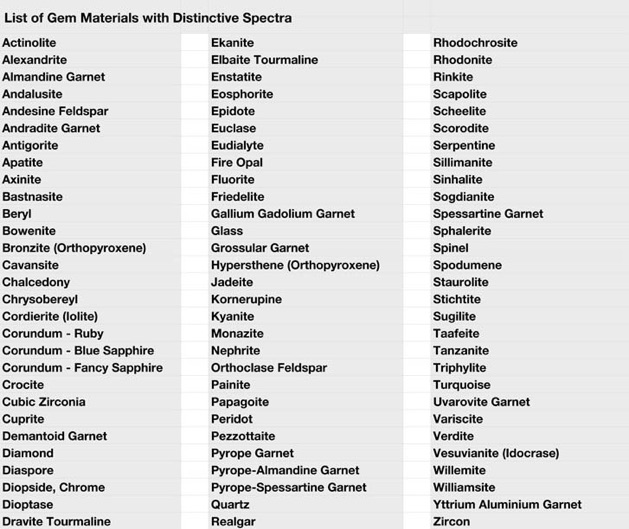
SELECTIVE ABSORPTION. When white light passes through a substance it is selectively absorbed at different wavelengths and the resultant light that passes through provides the color of the object. White light can be broken down into its component colors, red, orange, yellow, green, blue, indigo and violet and each color travels at a different velocity and has a different range of wavelengths that define it. Colors other than the spectral seven are cause by the mixture of various wavelengths of light. Visible light ranges from about 390 nanometers to about 750 nanometers in wavelength, and the wavelengths range immediately below violet is the ultraviolet and those beyond red, infrared. While humans have no visual acuity in the infrared and ultraviolet, spectrophotometers are instruments that can record absorption or transmission in those wavelengths in addition to visible light.
Selective absorption in gems is caused by crystal chemistry, the combination of a gem’s chemical composition and its crystal structure. When one looks through a spectroscope one will often find one or more diagnostic absorption bands that characterize the material.
PRISM & DIFFRACTION GRATING SCOPES. Prism spectroscopes use dispersion to break light into its component colors and all early spectroscopes were prism units and these also tend to be the most common types used in gemology. Diffraction grating scopes use the principal of diffraction where light enters through a slit and impacts a thin film of diffraction grating material. There are not many diffraction grating spectroscopes used in gemology but a high resolution diffraction grating provides superior results and is used often in astronomy and also in the two gemological spectrometers made by Imperial Gem instruments. As a practical matter in a diffraction grating the spectrum is more linear where with a prism scope the spectra appears expanded in the blue and compressed in the red.
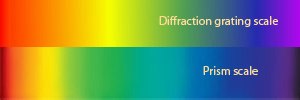
In my view, there are several issues to consider. Among them:
EASE OF USE. With a fixed slit and fixed focus the OPL diffraction grating Teaching scope is what I generally recommend for beginning or casual spectroscopists and is quick and easy. The cheaper prism scopes also have fixed slits and focus (e.g. the generic Asian scope sold by I.S.G. with light base). Better scopes have fixed slits but adjustable focus and the best have adjustable slits and adjustable focus.
LIGHTING GEOMETRY. A good base is an important consideration and should be capable of both adjustable transmitted light (iris diaphragm and rheostat) with the stone directly between the light source and the spectroscope, as well as reflected light where the stone is situated table down and the light source is at roughly 45° and the spectroscope is at an opposite 45° angle. You'll need reflected light for non-transparent stones like jade. You can either buy a spectroscope base, or cobble one together with a fiber optic light source or even a Maglight.
INTERNAL SCALE. Basil Anderson, who was the first to formally promulgate the use of spectroscopes in gemology felt that pattern recognition was the best way to use a spectroscope and so no internal scale that read the wavelength of absorption lines was necessary. I come down on the opposite side of the spectrum (pun intended) and absolutely believe that an internal scale is highly useful to beginners and experienced spectroscopists alike. Most internal scales have a separate parallel smaller diameter barrel into which a small light source shines to provide illumination to the scale superimposed on the spectrum. Such scales are not highly accurate but provide valuable information. To use pattern recognition you must have a photo or drawing of a near matching spectral distribution for either a prism or diffraction grating spectroscope. However, with a scale you just need the printed wavelength locations of the absorption spectra. Indeed, everywhere in the gemological literature the description of the lines in a spectrum include the location in nanometers or Ångstrom units.
ACCLIMATION. Basil Anderson postulated that as one gets older the vitreous humor of the eye starts to yellow and causes a decrease in visual acuity when viewing the blue and violet portions of the spectrum. Irrespective of your age or visual acuity the lines in the deep blue are the most difficult to discern. The proper way to use the spectroscope is to use it in a darkened room with your eyes fully acclimated to the dark and to erect a light shield so that your eyes will not inadvertently encounter your light source. This, unfortunately is quite time consuming but if you want accurate observations, it's necessary.
GEMOLOGICAL SPECTROMETERS. Imperial Gem instruments builds the Challenger Gemological Spectrometer and the new MDM Direct Reading Digital Gem Spectroscope. These units use diffraction gratings and B&W video cameras and monitors (B&W being much better at discerning the dark absorption bands than color equipment) with a separate digital LCD readout accurate to 1 nm. You can measure the wavelength of each absorption band with excellent precision and accuracy and you can do it very quickly without light acclimation. In the case of the Challenger you can get readings in the near infrared as well. With these units you can routinely see absorption lines you would have no hope of detecting with a conventional spectroscope and you can make identifications/separations that you could not make otherwise. The price of the new MDM is $1200 and the Challenger, $3200.
EBAY. EBay is a good source for older prism spectroscopes. Offerings by Beck, Zeiss, Krüss and Lafayette can be found at reasonable cost. With spectroscopes, you get what you pay for and generic Asian knock-offs abound. Caveat emptor.
OPL. Don't forget, with the $100 OPL Teaching Spectroscope a Maglight and a little ingenuity you do a lot of quality determinative gem work (click here for the OPL site)
------------------------------------------------------------------------------------------------------------------------------------------------------------------------------------------------------------
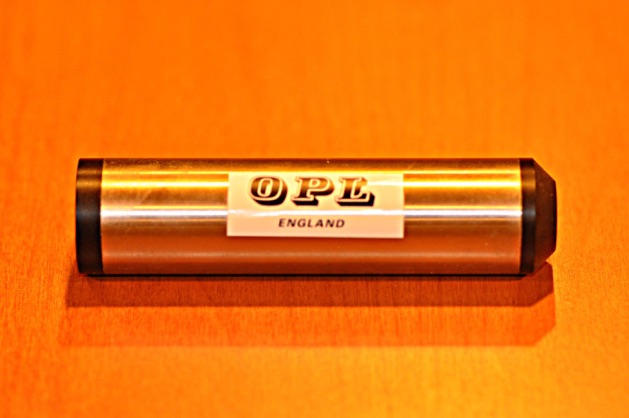
The OPL Teaching scope is very easy to use, effective and inexpensive.

The Beck prism scope has an adjustable slit and focus and has long been a staple in the gemological community.
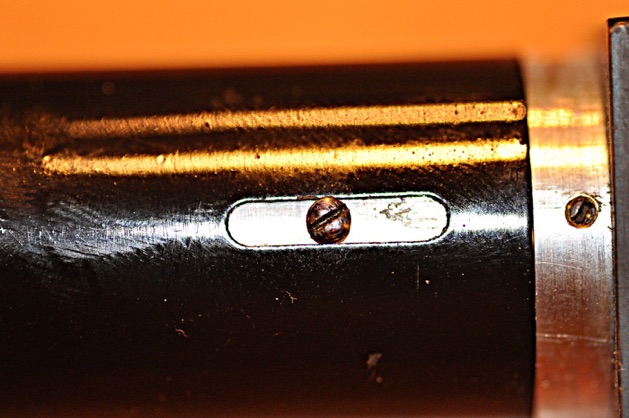
Tha barrel of the Beck can be moved in and out for focus and is tensioned by this screw.
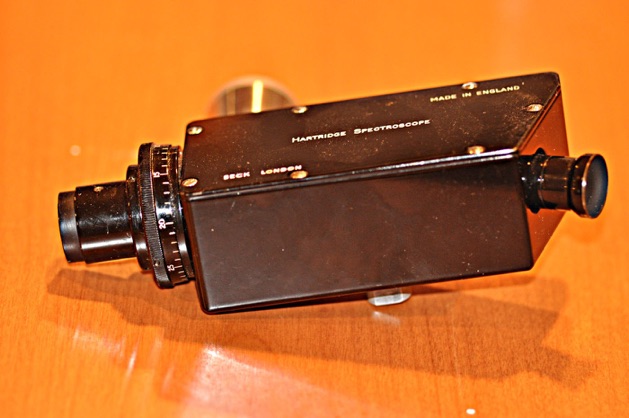
The Hartridge reversion spectroscope by Beck is an amazing piece of precision equipment. The slit width is highly controllable by the rotating dial at the left. When looking through the eyepiece you encounter two spectrums that are opposite one another. Lines can be moved and precisely matched by turning a vernier scale and the wavelegth to the nearest Angstrom unit read off the scale.

The vernier on the Hartridge scope allow you to read the wavelength of the spectral line of interest. Here the wavelength reads 5413 Å or 541.3 nm.

This Krüss prism spectroscope can be focused but has a fixed slit width. The plastic piece perpendicular to the long axis of the scope is for mounting the scope on the Eickhorst M9 base.
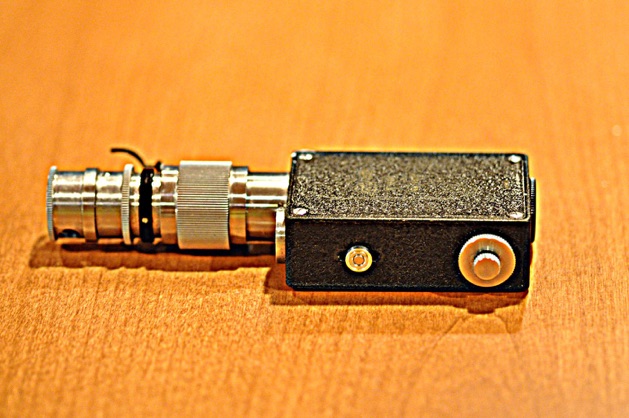
This older Lafayette prism spectroscope was designed to have an ampule of blood inserted into the light path to detect carbon monoxide. However, it works nicely as a gemological unit.
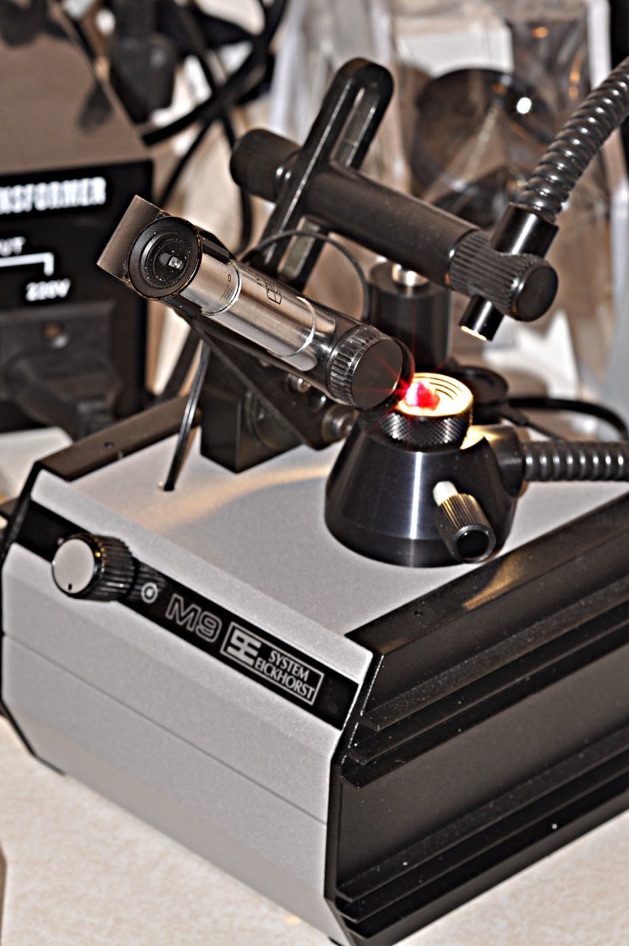
The Eickhorst M9 base with a 100W light source is fitted with a Zeiss spectroscope with lighted wavelength scale. The unit is shown in reflectance mode. Note the 90° angle between the scope and the light-source.

Here the M9 is shown in transmission mode with the light shining directly up through the stone into the spectroscope. In this photo you can see the smaller auxiliary barrel that contains the scale on the left side of the Zeiss scope. A small lightsource is mounted below inside the attachment arm and illuminates the scale that is superimposed over the spectra.
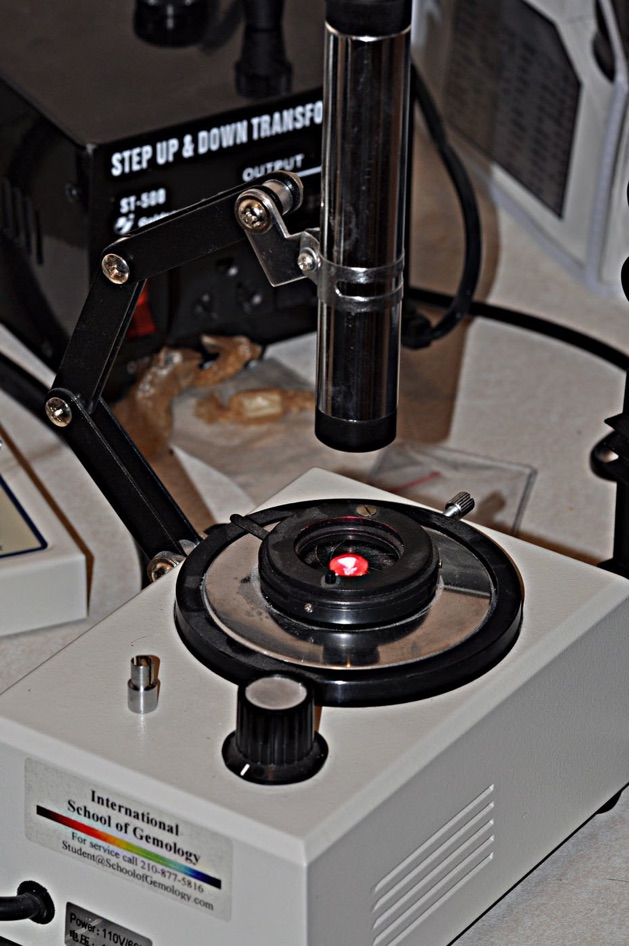
ISG sells a very basic stand and light source along with a generic Asian prism scope.
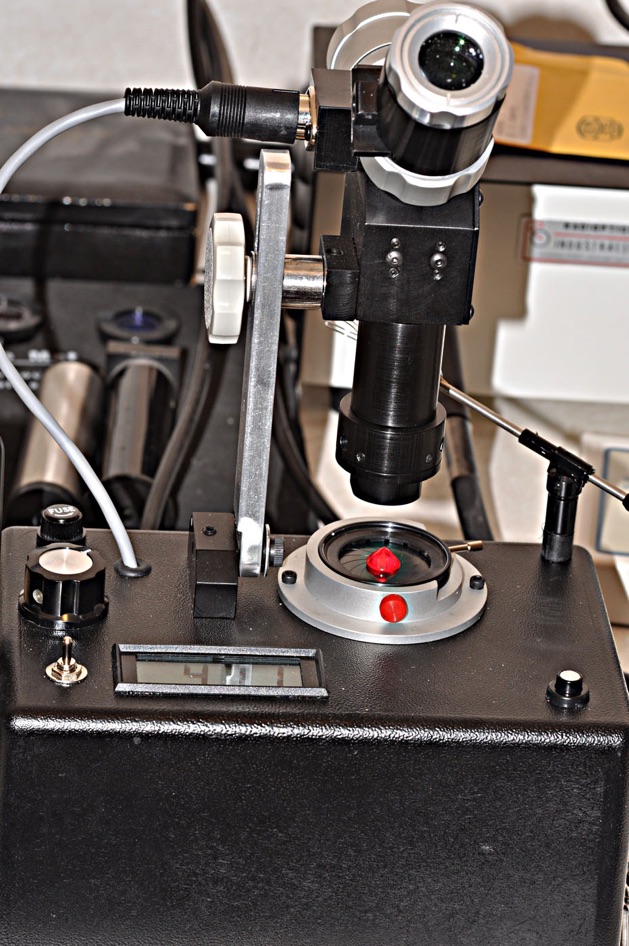
The MDM is an advanced digital direct reading spectroscope available from Imperial Gem Instruments for a very reasonable price of about $1300. The absorption lines can be matched with an internal marker in the scope and read directly off the digital scale. A B&W camera and monitor are available as add-ons and dramatically increase perception.

The Challenger is another offering from IGI that adds the ability to read spectra in the infrared. Readings are very fast and accurate.


